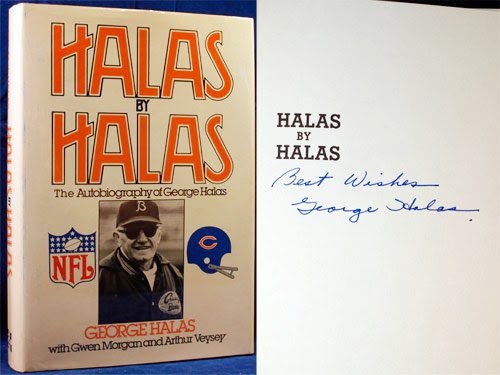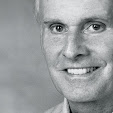Pro Football and Youth Violence: What Do They Have in Common? (Papa Bear George Halas had the right idea)
Nothing, you might think, nothing whatsoever. Chicagoans live for pro football. And they run like hell from youth violence. Case closed.
But look again. Look at Chicago's media. Think about how they make money: how they use both pro football and youth violence to create huge audiences of consumers - of sports fans and frightened citizens - which they then deliver to advertisers. That's how they make money. And they don't do it individually. Media do it collectively!
But there's more. Ask yourself: what are Chicago's media doing collectively today to empower Chicagoans to solve youth violence and to create safe neighborhoods? All this by contrast with the nonstop disempowering accounts of dangerous neighborhoods that presently dominates media coverage of youth violence in Chicago.
Not much. Next to nothing. You see little bits and pieces here and there: the Tribune's commendably citizen participatory New Plan of Chicago. But not even other Tribune Corp media have shown any interest it it. Then, there are stories on Chicago Public Radio, but nonwhites in Chicago's rough neighborhoods don't listen to WBEZ. Finally, there's nothing meaningful on the city's mainstream TV stations, all of which are licensed in the public interest by the Federal Communications Commission.
Now contrast neglect of solutions for youth violence in Chicago's media with media's obsessive coverage of the search for solutions to the Bear's dismal 2014 season. It's mountains to molehills.
So here's my point: With all this in mind, would you believe that there was once a time in Chicago when George Halas' Chicago Bears couldn't beg, borrow or steal coverage of any kind in Chicago's media?
The link of media neglect pro football and youth violence reduction hit me several weeks ago as I reading Tribune sports writer Don Pierson's terrific article about George Halas and the early days of pro football in Chicago. There was a time, Pierson says, when
But Halas on Halas is much more than that. It shows how George Halas was able to create a symbiosis betweeen his Chicago Bears and Chicago's media. So do you want to work for safe neighborhoods in Chicago? Then do what Halas did: create a mutually beneficial symbiosis between the city's media and Chicagoans who want safe neighborhoods.
Halas, quoted by Pierson below, does a beautiful job of telling the story of how he himself initiated this symbiosis:
Sound impossible? Think again. This possibility could be inevitable.
OK, so there's no denying that "Pro football gives advertisers more bang for their buck than anything else, not even close", as Pierson observes. But that's only where things stand today.
So why would citizen-participatory violence reduction efforts give advertisers the more bang for their buck in years to come? There are lots of reasons. At this blog I talk them. Here's just two.
First, ask yourself: what really and truly matters more to the man on the street in Chicago and to the future of the Chicagoland region: the fantasy of a winning sports teams or the hard benefits, social and economic, of safe, prosperous, happy neighborhoods?
Second: Don Pierson concludes his piece by pointing to certain unsavory truths about pro football. These now threaten football's once-untouchable symbiosis with media. He identifies several: concussions, off-field violence and "Is football the next tobacco".
He calls them "cracks in pro football's golden egg, exposing an ominous core".
And he asserts that "truth always prevails, eventually".
What would George Halas say to all this? George Halas, who on page 321 of Halas on Halas lamented the decline of physical fitness in America and charged "Schools [with creating] elaborate sports programs, unfortunately designed not for the participation of all students but to develop the few super players. The great masses of students are moved from the playing fields to bleachers."
But look again. Look at Chicago's media. Think about how they make money: how they use both pro football and youth violence to create huge audiences of consumers - of sports fans and frightened citizens - which they then deliver to advertisers. That's how they make money. And they don't do it individually. Media do it collectively!
But there's more. Ask yourself: what are Chicago's media doing collectively today to empower Chicagoans to solve youth violence and to create safe neighborhoods? All this by contrast with the nonstop disempowering accounts of dangerous neighborhoods that presently dominates media coverage of youth violence in Chicago.
Not much. Next to nothing. You see little bits and pieces here and there: the Tribune's commendably citizen participatory New Plan of Chicago. But not even other Tribune Corp media have shown any interest it it. Then, there are stories on Chicago Public Radio, but nonwhites in Chicago's rough neighborhoods don't listen to WBEZ. Finally, there's nothing meaningful on the city's mainstream TV stations, all of which are licensed in the public interest by the Federal Communications Commission.
Now contrast neglect of solutions for youth violence in Chicago's media with media's obsessive coverage of the search for solutions to the Bear's dismal 2014 season. It's mountains to molehills.
So here's my point: With all this in mind, would you believe that there was once a time in Chicago when George Halas' Chicago Bears couldn't beg, borrow or steal coverage of any kind in Chicago's media?
 |
| George Halas, back in his semipro days when media completely ignored pro football |
Bears founder George Halas, who practically invented play for pay, was his own press agent, writing articles in the 1920s for newspapers that thought the college game was the only pure and true football worth covering.Pierson's source is Halas on Halas, Halas' 1979 autobiography. Thanks to Pierson, I just read it. There are books. And then there are Books. Books convey soul the writer. Halas on Halas is a Book. And a remedy the Bears' sorry 2014 season.
 |
| Get it for a buck at Amazon.com! |
But Halas on Halas is much more than that. It shows how George Halas was able to create a symbiosis betweeen his Chicago Bears and Chicago's media. So do you want to work for safe neighborhoods in Chicago? Then do what Halas did: create a mutually beneficial symbiosis between the city's media and Chicagoans who want safe neighborhoods.
Halas, quoted by Pierson below, does a beautiful job of telling the story of how he himself initiated this symbiosis:
"At last the newspapers discovered the Bears. I kept writing articles about upcoming games, and by reading the papers I learned editors like superlatives. I blush when I think how many times I wrote that the next game was going to be the most difficult of the season, or how a new player was the fastest man in the West. I would write how fearless they were on the field, but what fine gentlemen they were at all other times.
"One glorious Monday I awoke to find the Chicago Tribune had made our game its top sports story. I went to the Tribune and thanked the young sports editor, Don Maxwell."
Leave it to Halas, of course, to point out the symbiotic relationship between his enterprise and newspapers: "Maxwell said, 'The Tribune and I should thank you. Sunday in autumn is a dull sports day. We need something exciting for our Monday pages.' "Halas, in short, did the Tribune a big favor. He gave it a new way to sell papers. That's what proponents of violence reduction in Chicago can do with Chicago's media today: help media make violence reduction a profitable proposition.
Sound impossible? Think again. This possibility could be inevitable.
OK, so there's no denying that "Pro football gives advertisers more bang for their buck than anything else, not even close", as Pierson observes. But that's only where things stand today.
So why would citizen-participatory violence reduction efforts give advertisers the more bang for their buck in years to come? There are lots of reasons. At this blog I talk them. Here's just two.
First, ask yourself: what really and truly matters more to the man on the street in Chicago and to the future of the Chicagoland region: the fantasy of a winning sports teams or the hard benefits, social and economic, of safe, prosperous, happy neighborhoods?
Second: Don Pierson concludes his piece by pointing to certain unsavory truths about pro football. These now threaten football's once-untouchable symbiosis with media. He identifies several: concussions, off-field violence and "Is football the next tobacco".
He calls them "cracks in pro football's golden egg, exposing an ominous core".
And he asserts that "truth always prevails, eventually".
What would George Halas say to all this? George Halas, who on page 321 of Halas on Halas lamented the decline of physical fitness in America and charged "Schools [with creating] elaborate sports programs, unfortunately designed not for the participation of all students but to develop the few super players. The great masses of students are moved from the playing fields to bleachers."
 |
| George Halas announces Mike Ditka as head coach, Jan 20 1982 (Tribune File Photo) |
Labels: "Is football the next tobacco", Chicago media, Chicago Tribune, Don Pierson, George Halas, New Plan of Chicago. Halas on Halas, youth violence



2 Comments:
Take about this article about the Polk Bros stores that operated in Chicago from the late 1930s to around 1990. http://tutormentor.blogspot.com/2014/01/lessons-from-polk-bros-power-of.html They were masters of advertising, just as George Halas was.
For Chicago and other cities to mobilize and sustain the flow of resources and distribution of great youth programs needed in all areas of high poverty, and high concentrations of violence and joblessness, we need leaders from sports, media, business, entertainment who use their own advertising media and talent to draw daily attention, and resources, to hundreds, or even thousands, of neighborhood "retail locations" that offer hope, opportunity and paths to brighter futures" to at risk youth.
Frank L Baum (Wizard of Oz) was another master advertiser, famous for the wondrous Marshall Fields display windows that riveted State Street shoppers at Christmas.
Boy do we need leaders. So where are they? Derek "I cant breathe" Rose did his part (see Jan 10 post, above). And I'm willing to consider that Rahm Emanuel may actually doing more to reduce youth violence than earlier mayors - yet he has not found a way of communicating with the man/woman on the street that is gets through to them.
Post a Comment
Subscribe to Post Comments [Atom]
<< Home